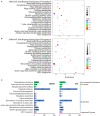Transcriptional and Metabolic Responses of Maize Shoots to Long-Term Potassium Deficiency
- PMID: 35812972
- PMCID: PMC9260415
- DOI: 10.3389/fpls.2022.922581
Transcriptional and Metabolic Responses of Maize Shoots to Long-Term Potassium Deficiency
Abstract
Potassium is important for plant growth and crop yield. However, the effects of potassium (K+) deficiency on silage maize biomass yield and how maize shoot feedback mechanisms of K+ deficiency regulate whole plant growth remains largely unknown. Here, the study aims to explore the maize growth, transcriptional and metabolic responses of shoots to long-term potassium deficiency. Under the K+ insufficiency condition, the biomass yield of silage maize decreased. The transcriptome data showed that there were 922 and 1,107 differential expression genes in DH605 and Z58, respectively. In the two varieties, 390 differently expressed overlapping genes were similarly regulated. These genes were considered the fundamental responses to K+ deficiency in maize shoots. Many stress-induced genes are involved in transport, primary and secondary metabolism, regulation, and other processes, which are involved in K+ acquisition and homeostasis. Metabolic profiles indicated that most amino acids, phenolic acids, organic acids, and alkaloids were accumulated in shoots under K+ deficiency conditions and part of the sugars and sugar alcohols also increased. It revealed that putrescine and putrescine derivatives were specifically accumulated under the K+ deficiency condition, which may play a role in the feedback regulation of shoot growth. These results confirmed the importance of K+ on silage maize production and provided a deeper insight into the responses to K+ deficiency in maize shoots.
Keywords: biomass yield; metabolome; potassium; silage maize; transcriptome.
Copyright © 2022 Xiong, Wang, Guo, Tang, Zhao, Yang, Pei, Chen, Song and Sun.
Conflict of interest statement
The authors declare that the research was conducted in the absence of any commercial or financial relationships that could be construed as a potential conflict of interest.
Figures





Similar articles
-
Integrated transcriptomic and metabolomic analyses reveal key metabolic pathways in response to potassium deficiency in coconut (Cocos nucifera L.) seedlings.Front Plant Sci. 2023 Feb 13;14:1112264. doi: 10.3389/fpls.2023.1112264. eCollection 2023. Front Plant Sci. 2023. PMID: 36860901 Free PMC article.
-
Transcript profile of the response of two soybean genotypes to potassium deficiency.PLoS One. 2012;7(7):e39856. doi: 10.1371/journal.pone.0039856. Epub 2012 Jul 5. PLoS One. 2012. PMID: 22792192 Free PMC article.
-
Glutamine application promotes nitrogen and biomass accumulation in the shoot of seedlings of the maize hybrid ZD958.Planta. 2020 Feb 17;251(3):66. doi: 10.1007/s00425-020-03363-9. Planta. 2020. PMID: 32065312
-
Genetic approaches for improvement of the crop potassium acquisition and utilization efficiency.Curr Opin Plant Biol. 2015 Jun;25:46-52. doi: 10.1016/j.pbi.2015.04.007. Epub 2015 May 15. Curr Opin Plant Biol. 2015. PMID: 25941764 Review.
-
Potassium homeostasis and signalling: from the whole plant to the subcellular level.Quant Plant Biol. 2025 May 8;6:e13. doi: 10.1017/qpb.2025.10. eCollection 2025. Quant Plant Biol. 2025. PMID: 40391039 Free PMC article. Review.
Cited by
-
Genome-wide identification and functional roles relating to anthocyanin biosynthesis analysis in maize.BMC Plant Biol. 2025 Jan 15;25(1):57. doi: 10.1186/s12870-025-06053-4. BMC Plant Biol. 2025. PMID: 39810086 Free PMC article.
-
Dynamic transcriptome analysis unravels key regulatory genes of maize root growth and development in response to potassium deficiency.Planta. 2023 Oct 14;258(5):99. doi: 10.1007/s00425-023-04260-7. Planta. 2023. PMID: 37837470 Free PMC article.
-
Transcriptomic and physiological insights into auxin-mediated root growth and potassium uptake in tobacco under low-potassium stress.BMC Plant Biol. 2025 May 19;25(1):664. doi: 10.1186/s12870-025-06600-z. BMC Plant Biol. 2025. PMID: 40389823 Free PMC article.
-
Integrated Physiological and Metabolomic Analyses Reveal the Differences in the Fruit Quality of the Blueberry Cultivated in Three Soilless Substrates.Foods. 2022 Dec 7;11(24):3965. doi: 10.3390/foods11243965. Foods. 2022. PMID: 36553707 Free PMC article.
-
Integrated transcriptomic and metabolomic analyses reveal key metabolic pathways in response to potassium deficiency in coconut (Cocos nucifera L.) seedlings.Front Plant Sci. 2023 Feb 13;14:1112264. doi: 10.3389/fpls.2023.1112264. eCollection 2023. Front Plant Sci. 2023. PMID: 36860901 Free PMC article.
References
LinkOut - more resources
Full Text Sources

